Corporate Finance Assignment: Valuation and NPV Analysis
VerifiedAdded on 2022/09/07
|7
|1254
|15
Report
AI Summary
This report presents a comprehensive solution to a corporate finance assignment. It begins by calculating the intrinsic value of shares using the price-earnings approach, dividend discount model, and net realisable value approach. The report then analyzes the advantages and disadvantages of each method, with a specialist recommending the dividend discount model. The second part of the report calculates the Net Present Value (NPV) of a project, including cash flows, depreciation, taxation, and scrap value. The report concludes with a decision on whether to accept the project based on the positive NPV and provides references. The assignment covers key corporate finance concepts such as valuation, NPV, and financial analysis, and provides detailed calculations and explanations.

Running head: REPORT 0
CORPORATE FINANCE
DECEMBER 26, 2019
STUDENT DETAILS:
CORPORATE FINANCE
DECEMBER 26, 2019
STUDENT DETAILS:
Paraphrase This Document
Need a fresh take? Get an instant paraphrase of this document with our AI Paraphraser
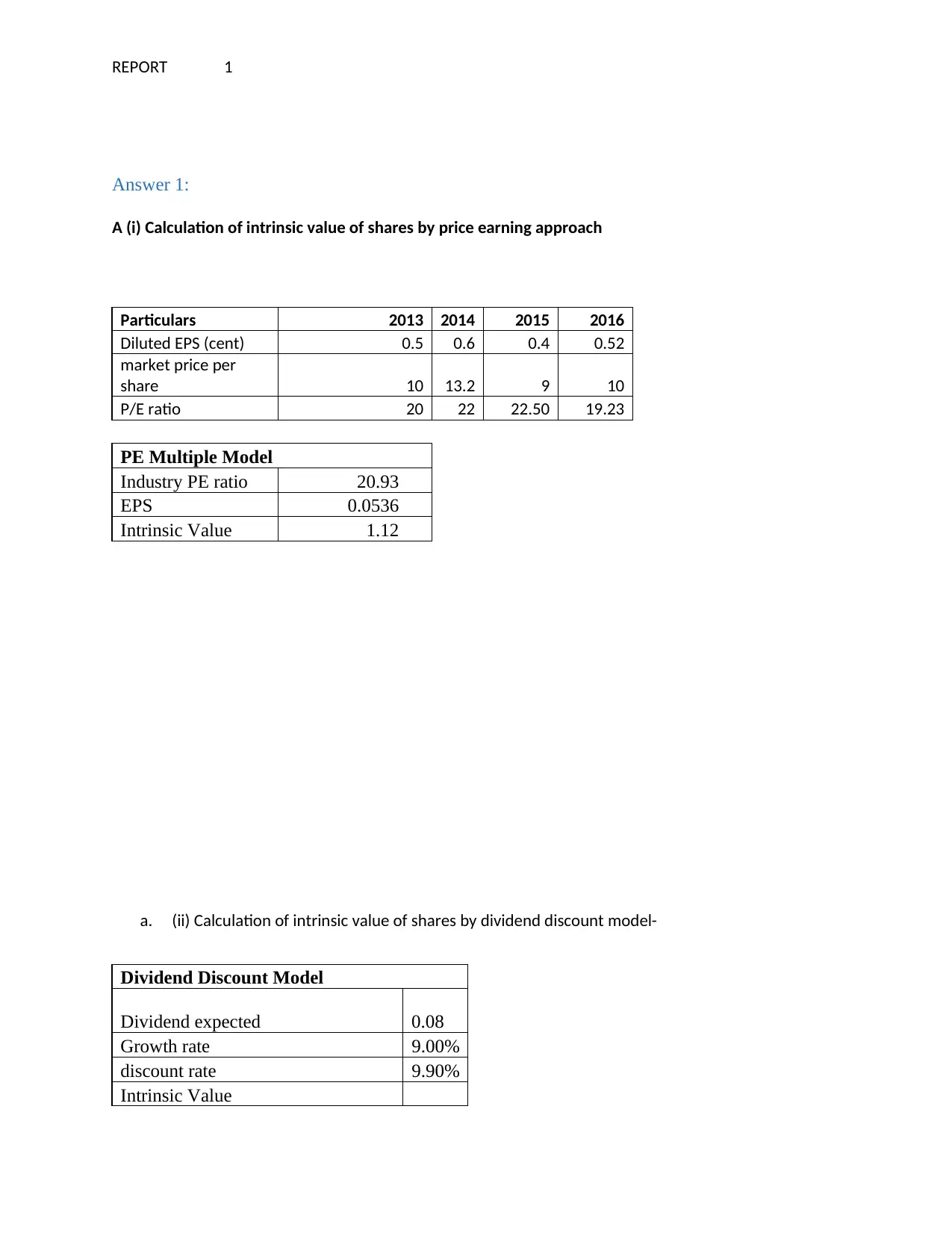
REPORT 1
Answer 1:
A (i) Calculation of intrinsic value of shares by price earning approach
Particulars 2013 2014 2015 2016
Diluted EPS (cent) 0.5 0.6 0.4 0.52
market price per
share 10 13.2 9 10
P/E ratio 20 22 22.50 19.23
PE Multiple Model
Industry PE ratio 20.93
EPS 0.0536
Intrinsic Value 1.12
a. (ii) Calculation of intrinsic value of shares by dividend discount model-
Dividend Discount Model
Dividend expected 0.08
Growth rate 9.00%
discount rate 9.90%
Intrinsic Value
Answer 1:
A (i) Calculation of intrinsic value of shares by price earning approach
Particulars 2013 2014 2015 2016
Diluted EPS (cent) 0.5 0.6 0.4 0.52
market price per
share 10 13.2 9 10
P/E ratio 20 22 22.50 19.23
PE Multiple Model
Industry PE ratio 20.93
EPS 0.0536
Intrinsic Value 1.12
a. (ii) Calculation of intrinsic value of shares by dividend discount model-
Dividend Discount Model
Dividend expected 0.08
Growth rate 9.00%
discount rate 9.90%
Intrinsic Value
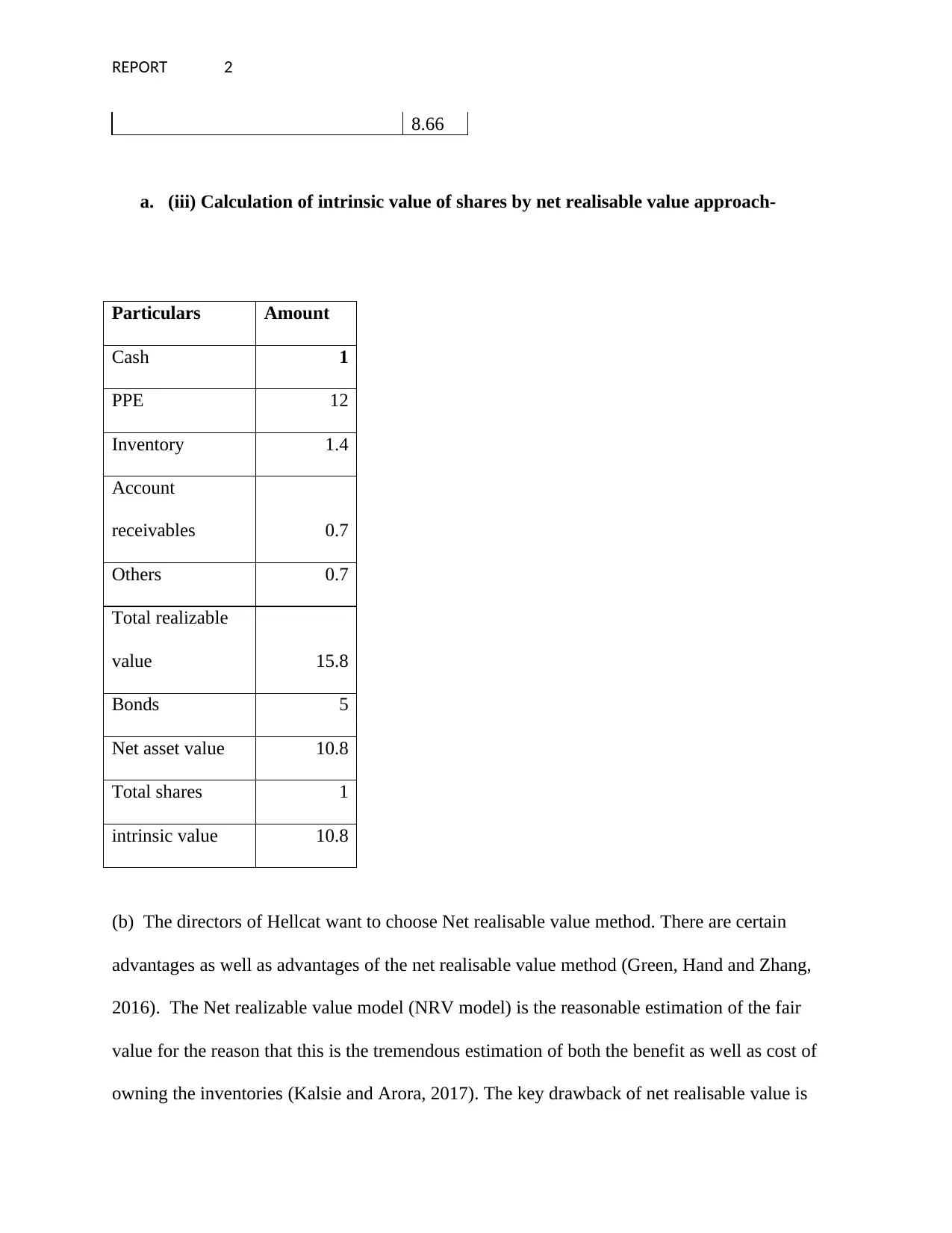
REPORT 2
8.66
a. (iii) Calculation of intrinsic value of shares by net realisable value approach-
Particulars Amount
Cash 1
PPE 12
Inventory 1.4
Account
receivables 0.7
Others 0.7
Total realizable
value 15.8
Bonds 5
Net asset value 10.8
Total shares 1
intrinsic value 10.8
(b) The directors of Hellcat want to choose Net realisable value method. There are certain
advantages as well as advantages of the net realisable value method (Green, Hand and Zhang,
2016). The Net realizable value model (NRV model) is the reasonable estimation of the fair
value for the reason that this is the tremendous estimation of both the benefit as well as cost of
owning the inventories (Kalsie and Arora, 2017). The key drawback of net realisable value is
8.66
a. (iii) Calculation of intrinsic value of shares by net realisable value approach-
Particulars Amount
Cash 1
PPE 12
Inventory 1.4
Account
receivables 0.7
Others 0.7
Total realizable
value 15.8
Bonds 5
Net asset value 10.8
Total shares 1
intrinsic value 10.8
(b) The directors of Hellcat want to choose Net realisable value method. There are certain
advantages as well as advantages of the net realisable value method (Green, Hand and Zhang,
2016). The Net realizable value model (NRV model) is the reasonable estimation of the fair
value for the reason that this is the tremendous estimation of both the benefit as well as cost of
owning the inventories (Kalsie and Arora, 2017). The key drawback of net realisable value is
⊘ This is a preview!⊘
Do you want full access?
Subscribe today to unlock all pages.

Trusted by 1+ million students worldwide
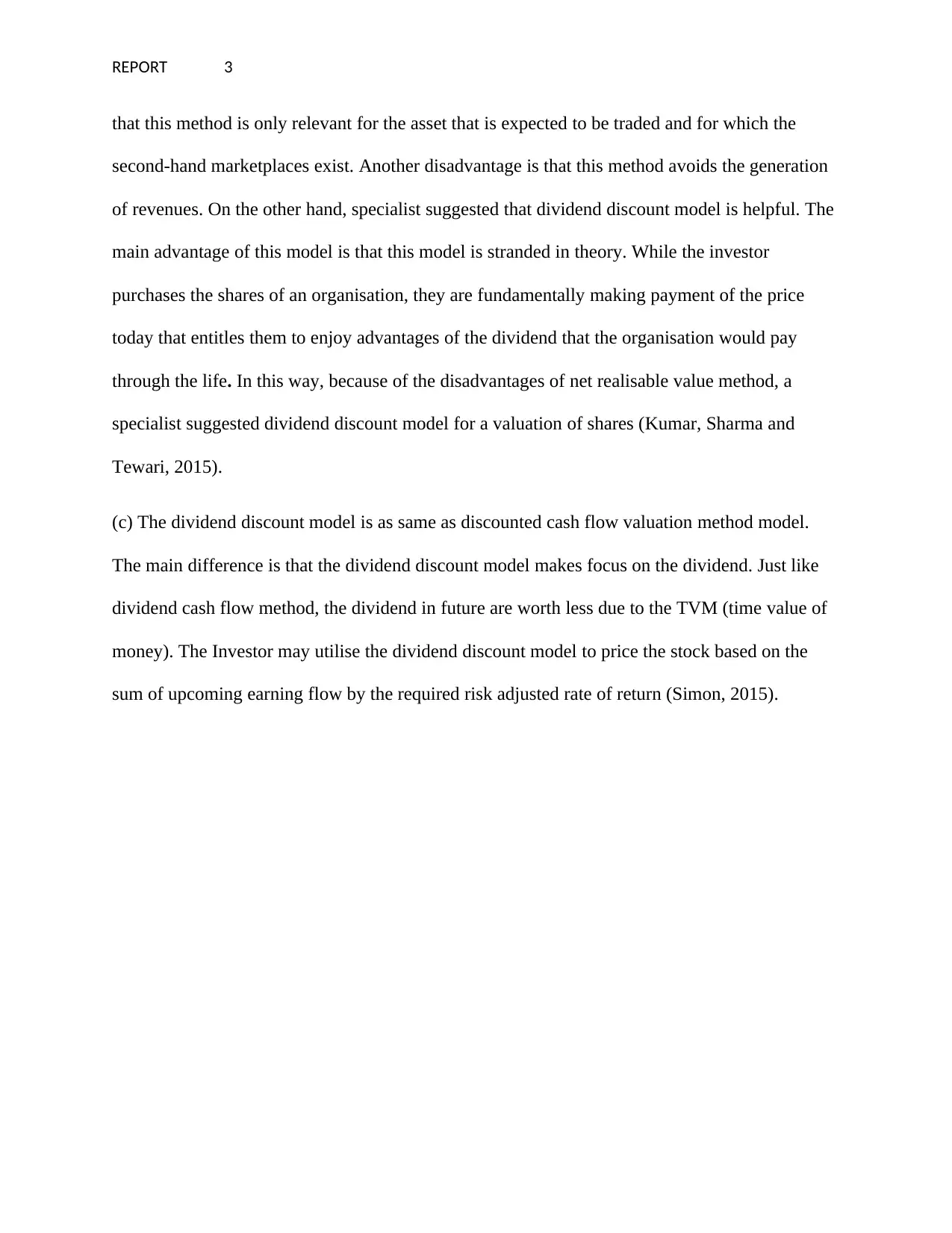
REPORT 3
that this method is only relevant for the asset that is expected to be traded and for which the
second-hand marketplaces exist. Another disadvantage is that this method avoids the generation
of revenues. On the other hand, specialist suggested that dividend discount model is helpful. The
main advantage of this model is that this model is stranded in theory. While the investor
purchases the shares of an organisation, they are fundamentally making payment of the price
today that entitles them to enjoy advantages of the dividend that the organisation would pay
through the life. In this way, because of the disadvantages of net realisable value method, a
specialist suggested dividend discount model for a valuation of shares (Kumar, Sharma and
Tewari, 2015).
(c) The dividend discount model is as same as discounted cash flow valuation method model.
The main difference is that the dividend discount model makes focus on the dividend. Just like
dividend cash flow method, the dividend in future are worth less due to the TVM (time value of
money). The Investor may utilise the dividend discount model to price the stock based on the
sum of upcoming earning flow by the required risk adjusted rate of return (Simon, 2015).
that this method is only relevant for the asset that is expected to be traded and for which the
second-hand marketplaces exist. Another disadvantage is that this method avoids the generation
of revenues. On the other hand, specialist suggested that dividend discount model is helpful. The
main advantage of this model is that this model is stranded in theory. While the investor
purchases the shares of an organisation, they are fundamentally making payment of the price
today that entitles them to enjoy advantages of the dividend that the organisation would pay
through the life. In this way, because of the disadvantages of net realisable value method, a
specialist suggested dividend discount model for a valuation of shares (Kumar, Sharma and
Tewari, 2015).
(c) The dividend discount model is as same as discounted cash flow valuation method model.
The main difference is that the dividend discount model makes focus on the dividend. Just like
dividend cash flow method, the dividend in future are worth less due to the TVM (time value of
money). The Investor may utilise the dividend discount model to price the stock based on the
sum of upcoming earning flow by the required risk adjusted rate of return (Simon, 2015).
Paraphrase This Document
Need a fresh take? Get an instant paraphrase of this document with our AI Paraphraser
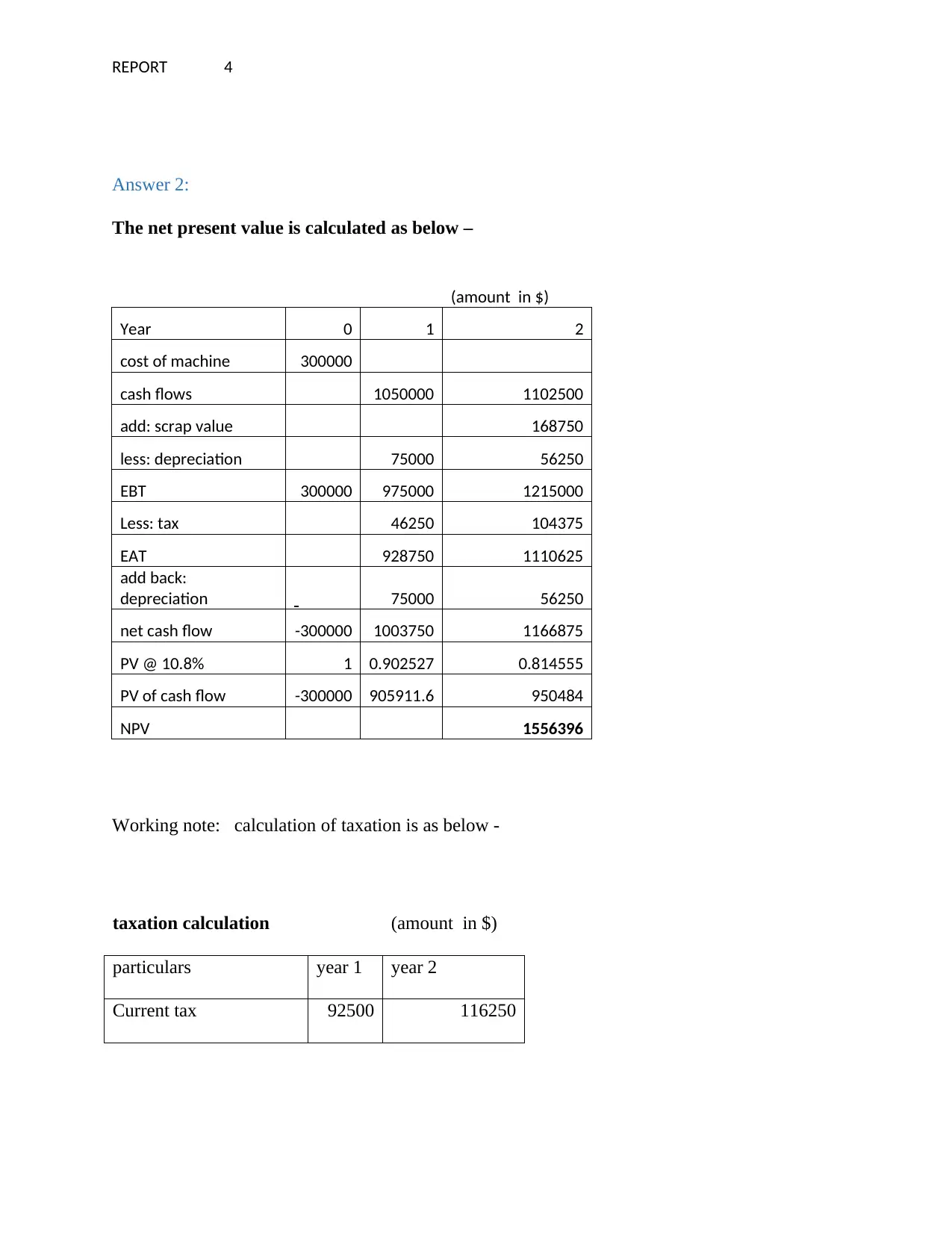
REPORT 4
Answer 2:
The net present value is calculated as below –
(amount in $)
Year 0 1 2
cost of machine 300000
cash flows 1050000 1102500
add: scrap value 168750
less: depreciation 75000 56250
EBT 300000 975000 1215000
Less: tax 46250 104375
EAT 928750 1110625
add back:
depreciation 75000 56250
net cash flow -300000 1003750 1166875
PV @ 10.8% 1 0.902527 0.814555
PV of cash flow -300000 905911.6 950484
NPV 1556396
Working note: calculation of taxation is as below -
taxation calculation (amount in $)
particulars year 1 year 2
Current tax 92500 116250
Answer 2:
The net present value is calculated as below –
(amount in $)
Year 0 1 2
cost of machine 300000
cash flows 1050000 1102500
add: scrap value 168750
less: depreciation 75000 56250
EBT 300000 975000 1215000
Less: tax 46250 104375
EAT 928750 1110625
add back:
depreciation 75000 56250
net cash flow -300000 1003750 1166875
PV @ 10.8% 1 0.902527 0.814555
PV of cash flow -300000 905911.6 950484
NPV 1556396
Working note: calculation of taxation is as below -
taxation calculation (amount in $)
particulars year 1 year 2
Current tax 92500 116250
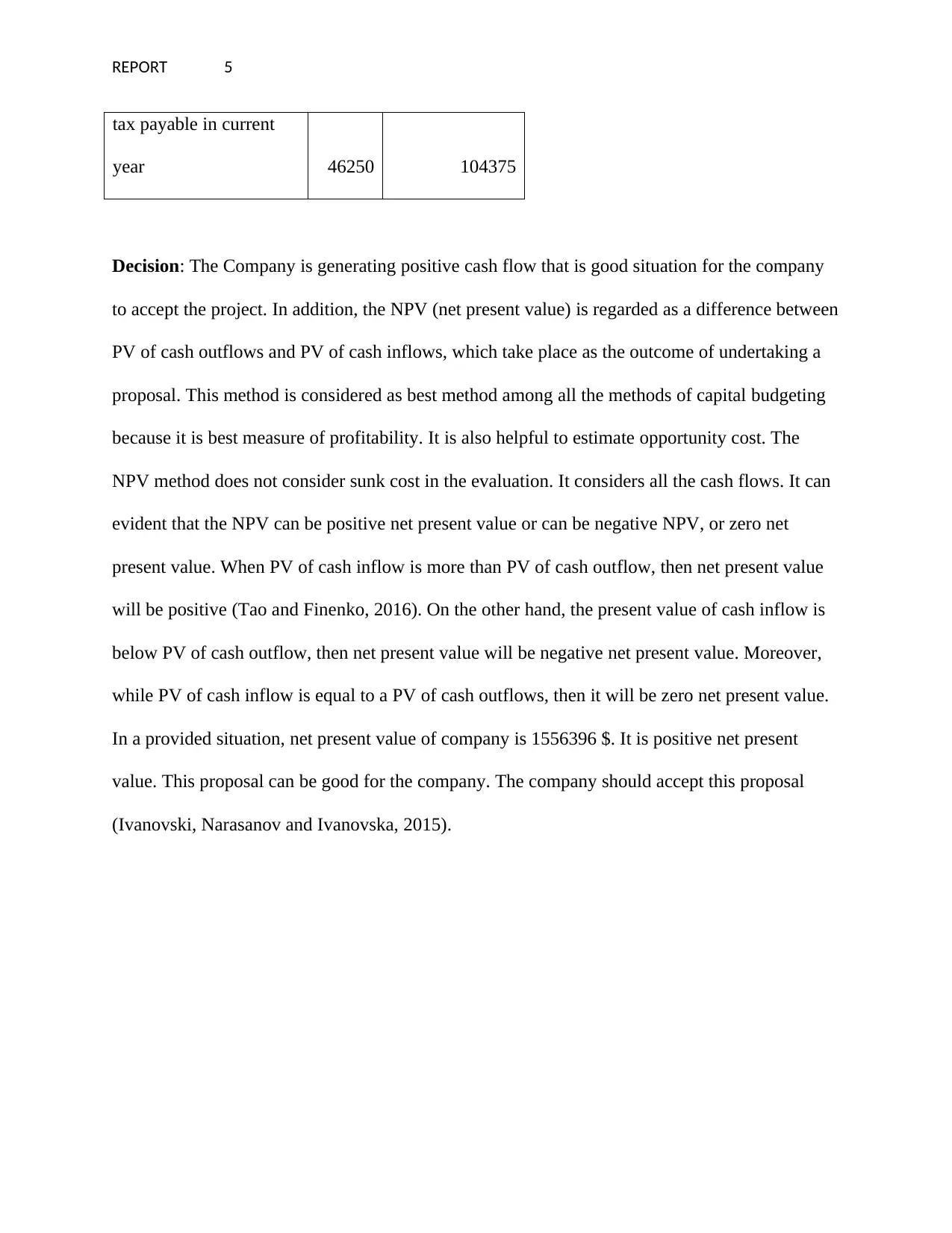
REPORT 5
tax payable in current
year 46250 104375
Decision: The Company is generating positive cash flow that is good situation for the company
to accept the project. In addition, the NPV (net present value) is regarded as a difference between
PV of cash outflows and PV of cash inflows, which take place as the outcome of undertaking a
proposal. This method is considered as best method among all the methods of capital budgeting
because it is best measure of profitability. It is also helpful to estimate opportunity cost. The
NPV method does not consider sunk cost in the evaluation. It considers all the cash flows. It can
evident that the NPV can be positive net present value or can be negative NPV, or zero net
present value. When PV of cash inflow is more than PV of cash outflow, then net present value
will be positive (Tao and Finenko, 2016). On the other hand, the present value of cash inflow is
below PV of cash outflow, then net present value will be negative net present value. Moreover,
while PV of cash inflow is equal to a PV of cash outflows, then it will be zero net present value.
In a provided situation, net present value of company is 1556396 $. It is positive net present
value. This proposal can be good for the company. The company should accept this proposal
(Ivanovski, Narasanov and Ivanovska, 2015).
tax payable in current
year 46250 104375
Decision: The Company is generating positive cash flow that is good situation for the company
to accept the project. In addition, the NPV (net present value) is regarded as a difference between
PV of cash outflows and PV of cash inflows, which take place as the outcome of undertaking a
proposal. This method is considered as best method among all the methods of capital budgeting
because it is best measure of profitability. It is also helpful to estimate opportunity cost. The
NPV method does not consider sunk cost in the evaluation. It considers all the cash flows. It can
evident that the NPV can be positive net present value or can be negative NPV, or zero net
present value. When PV of cash inflow is more than PV of cash outflow, then net present value
will be positive (Tao and Finenko, 2016). On the other hand, the present value of cash inflow is
below PV of cash outflow, then net present value will be negative net present value. Moreover,
while PV of cash inflow is equal to a PV of cash outflows, then it will be zero net present value.
In a provided situation, net present value of company is 1556396 $. It is positive net present
value. This proposal can be good for the company. The company should accept this proposal
(Ivanovski, Narasanov and Ivanovska, 2015).
⊘ This is a preview!⊘
Do you want full access?
Subscribe today to unlock all pages.

Trusted by 1+ million students worldwide
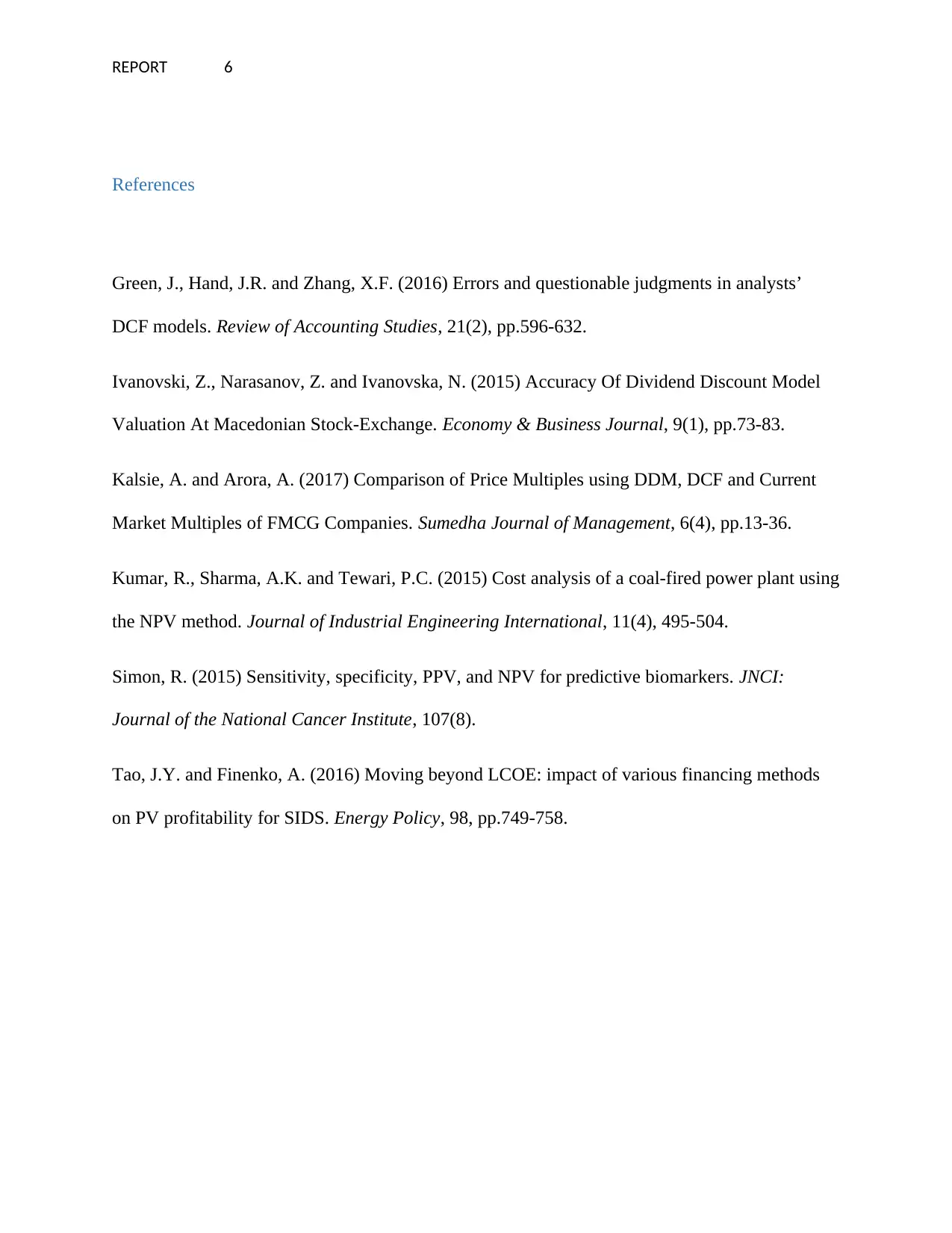
REPORT 6
References
Green, J., Hand, J.R. and Zhang, X.F. (2016) Errors and questionable judgments in analysts’
DCF models. Review of Accounting Studies, 21(2), pp.596-632.
Ivanovski, Z., Narasanov, Z. and Ivanovska, N. (2015) Accuracy Of Dividend Discount Model
Valuation At Macedonian Stock-Exchange. Economy & Business Journal, 9(1), pp.73-83.
Kalsie, A. and Arora, A. (2017) Comparison of Price Multiples using DDM, DCF and Current
Market Multiples of FMCG Companies. Sumedha Journal of Management, 6(4), pp.13-36.
Kumar, R., Sharma, A.K. and Tewari, P.C. (2015) Cost analysis of a coal-fired power plant using
the NPV method. Journal of Industrial Engineering International, 11(4), 495-504.
Simon, R. (2015) Sensitivity, specificity, PPV, and NPV for predictive biomarkers. JNCI:
Journal of the National Cancer Institute, 107(8).
Tao, J.Y. and Finenko, A. (2016) Moving beyond LCOE: impact of various financing methods
on PV profitability for SIDS. Energy Policy, 98, pp.749-758.
References
Green, J., Hand, J.R. and Zhang, X.F. (2016) Errors and questionable judgments in analysts’
DCF models. Review of Accounting Studies, 21(2), pp.596-632.
Ivanovski, Z., Narasanov, Z. and Ivanovska, N. (2015) Accuracy Of Dividend Discount Model
Valuation At Macedonian Stock-Exchange. Economy & Business Journal, 9(1), pp.73-83.
Kalsie, A. and Arora, A. (2017) Comparison of Price Multiples using DDM, DCF and Current
Market Multiples of FMCG Companies. Sumedha Journal of Management, 6(4), pp.13-36.
Kumar, R., Sharma, A.K. and Tewari, P.C. (2015) Cost analysis of a coal-fired power plant using
the NPV method. Journal of Industrial Engineering International, 11(4), 495-504.
Simon, R. (2015) Sensitivity, specificity, PPV, and NPV for predictive biomarkers. JNCI:
Journal of the National Cancer Institute, 107(8).
Tao, J.Y. and Finenko, A. (2016) Moving beyond LCOE: impact of various financing methods
on PV profitability for SIDS. Energy Policy, 98, pp.749-758.
1 out of 7
Related Documents
Your All-in-One AI-Powered Toolkit for Academic Success.
+13062052269
info@desklib.com
Available 24*7 on WhatsApp / Email
![[object Object]](/_next/static/media/star-bottom.7253800d.svg)
Unlock your academic potential
Copyright © 2020–2025 A2Z Services. All Rights Reserved. Developed and managed by ZUCOL.





